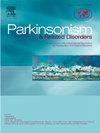Investigating the neural correlates of subjective sleep changes following subthalamic nucleus deep brain stimulation for Parkinson's disease
IF 3.4
3区 医学
Q2 CLINICAL NEUROLOGY
引用次数: 0
Abstract
Introduction
Sleep disturbances in Parkinson's disease (PD) are extremely common and significantly impact quality of life. Deep brain stimulation (DBS) of the subthalamic nucleus (STN) is an established therapy for motor symptoms and may also influence sleep outcomes. However, the relationship between stimulation location, structural networks, and sleep improvements remains poorly understood, particularly over longer durations.
Methods
We conducted a retrospective analysis of 53 PD patients implanted with bilateral STN-DBS. Sleep outcomes were assessed using self-report measures, with subsection scores for nighttime sleep, daytime wakefulness, and total sleep disturbance analysed. Local stimulation effects were modelled using sweet spot analyses, and innervated tracts were examined through discriminative fiber filtering. Associations with motor improvements and demographic factors were analysed.
Results
Significant improvements were reported in both nighttime sleep and daytime wakefulness. Motor symptom improvements were significantly positively associated with cumulative sleep scores but did not fully explain sleep changes. Sweet spot analyses revealed associations between cumulative sleep score improvements and the sensorimotor STN, while fiber filtering implicated brainstem, cerebellar, and cortical motor tracts for daytime and cumulative sleep improvements. These associations remained significant after controlling for motor improvements.
Discussion
Our findings suggest that STN-DBS may modulate sleep via broader structural connections and beyond motor symptom improvements. The lateralised effects and involvement of widespread tracts underscore the complexity of DBS-related sleep modulation. Future studies should incorporate longitudinal designs and objective measures to disentangle motor-independent mechanisms and optimise therapeutic strategies.
研究帕金森病丘脑下核深部脑刺激后主观睡眠变化的神经相关性
帕金森病(PD)的睡眠障碍极为常见,并显著影响生活质量。丘脑下核深部脑刺激(DBS)是一种治疗运动症状的成熟疗法,也可能影响睡眠结果。然而,刺激位置、结构网络和睡眠改善之间的关系仍然知之甚少,特别是在较长时间内。方法对53例PD患者双侧植入STN-DBS进行回顾性分析。使用自我报告方法评估睡眠结果,并分析夜间睡眠、白天清醒和总睡眠障碍的分分数。局部刺激效应通过甜蜜点分析建模,神经束通过鉴别纤维过滤检查。分析了运动改善与人口统计学因素的关系。结果夜间睡眠和日间清醒均有显著改善。运动症状的改善与累积睡眠评分显著正相关,但并不能完全解释睡眠变化。最佳点分析揭示了累积睡眠评分改善与感觉运动STN之间的联系,而纤维过滤与脑干、小脑和皮质运动束在白天和累积睡眠改善方面有关。在控制运动改善后,这些关联仍然显著。我们的研究结果表明,STN-DBS可能通过更广泛的结构连接调节睡眠,而不仅仅是运动症状的改善。侧化效应和广泛束的参与强调了dbs相关睡眠调节的复杂性。未来的研究应纳入纵向设计和客观措施,以解开运动独立机制和优化治疗策略。
本文章由计算机程序翻译,如有差异,请以英文原文为准。
求助全文
约1分钟内获得全文
求助全文
来源期刊

Parkinsonism & related disorders
医学-临床神经学
CiteScore
6.20
自引率
4.90%
发文量
292
审稿时长
39 days
期刊介绍:
Parkinsonism & Related Disorders publishes the results of basic and clinical research contributing to the understanding, diagnosis and treatment of all neurodegenerative syndromes in which Parkinsonism, Essential Tremor or related movement disorders may be a feature. Regular features will include: Review Articles, Point of View articles, Full-length Articles, Short Communications, Case Reports and Letter to the Editor.
 求助内容:
求助内容: 应助结果提醒方式:
应助结果提醒方式:


